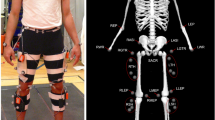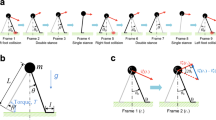Abstract
USING eight normal barefoot male subjects, we have studied, for both feet simultaneously, the timing characteristics of the various phases of heel and toe contact with the ground. Two types of experiment were performed for walking on the level, one with speed fixed at 4.5 feet/s while pace frequencies were varied between 1.25 and 4.00 per s; another with speeds of natural walking ranging from 2.0 to 6.7 feet/s. We chose to experiment with barefoot subjects to eliminate the possible influence of different footwear, recognizing that walking characteristics, with and without footwear, would not necessarily be identical. For both natural and forced pace walking we found that averages of the various footswitch phases, when normalized with respect to the average periodic time, remained fairly constant. Also, for natural walking, both pace frequency and step size seem to depend on the square root of the speed.
This is a preview of subscription content, access via your institution
Access options
Subscribe to this journal
Receive 51 print issues and online access
$199.00 per year
only $3.90 per issue
Buy this article
- Purchase on Springer Link
- Instant access to full article PDF
Prices may be subject to local taxes which are calculated during checkout
Similar content being viewed by others
References
Cotes, J. E., and Meade, F., Ergonomics, 3 (1960).
Author information
Authors and Affiliations
Rights and permissions
About this article
Cite this article
MILNER, M., QUANBURY, A. Facets of Control in Human Walking. Nature 227, 734–735 (1970). https://doi.org/10.1038/227734a0
Received:
Revised:
Issue Date:
DOI: https://doi.org/10.1038/227734a0
This article is cited by
-
Variant and invariant patterns embedded in human locomotion through whole body kinematic coordination
Experimental Brain Research (2010)
-
Sex difference in the pattern of lower limb movement during treadmill walking
European Journal of Applied Physiology and Occupational Physiology (1991)
-
Foot contact timing and the effect of walking speed in normal childhood and adult gait
Medical & Biological Engineering & Computing (1988)
Comments
By submitting a comment you agree to abide by our Terms and Community Guidelines. If you find something abusive or that does not comply with our terms or guidelines please flag it as inappropriate.



